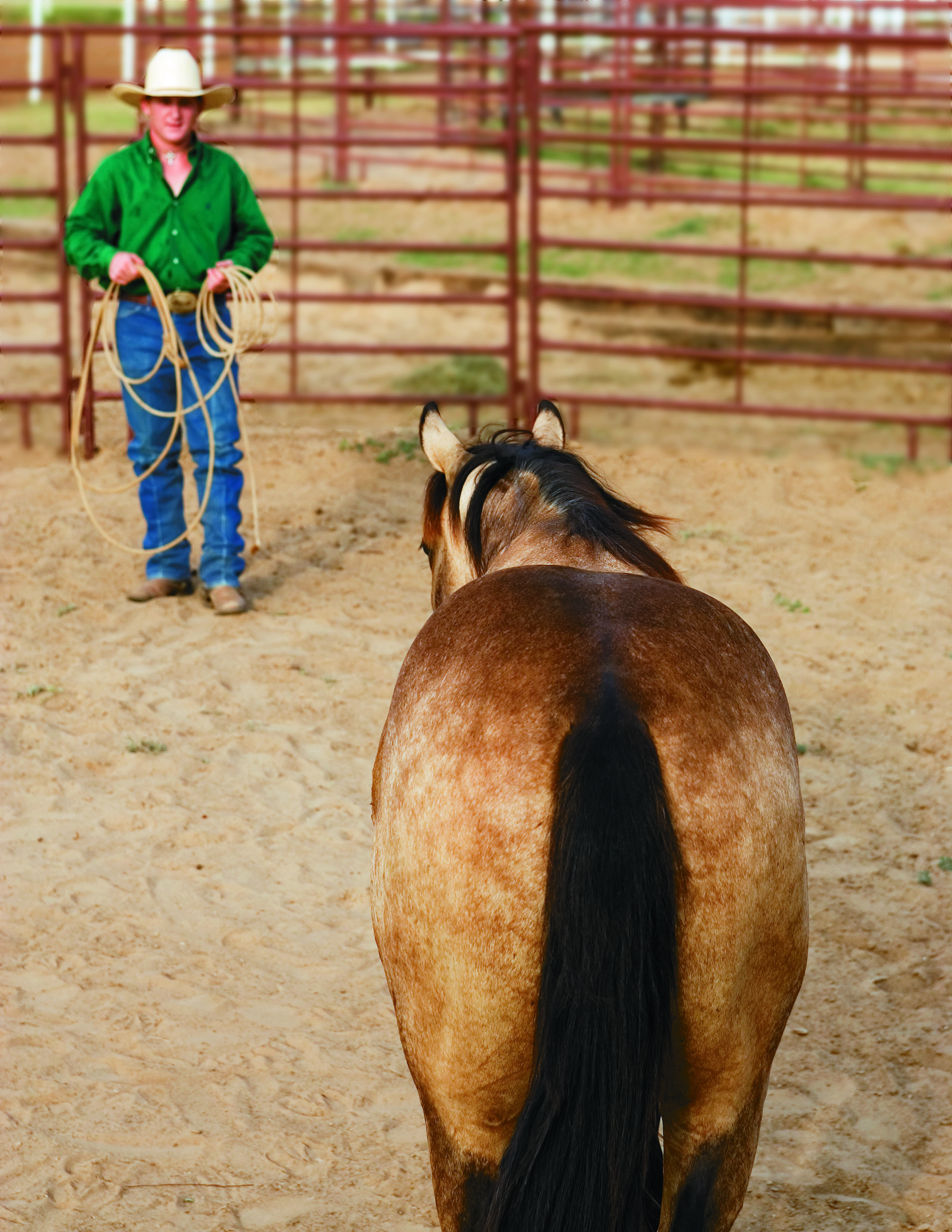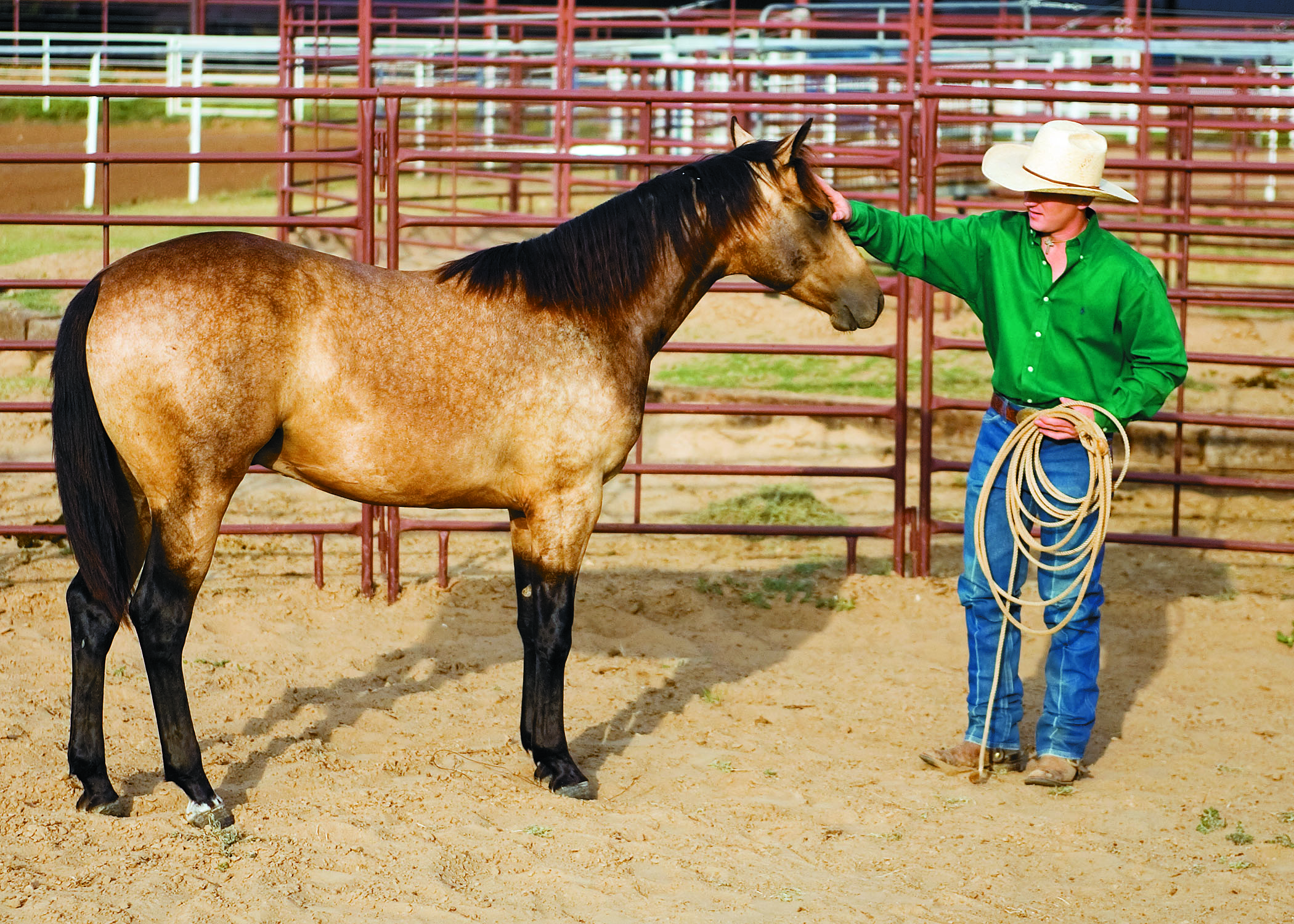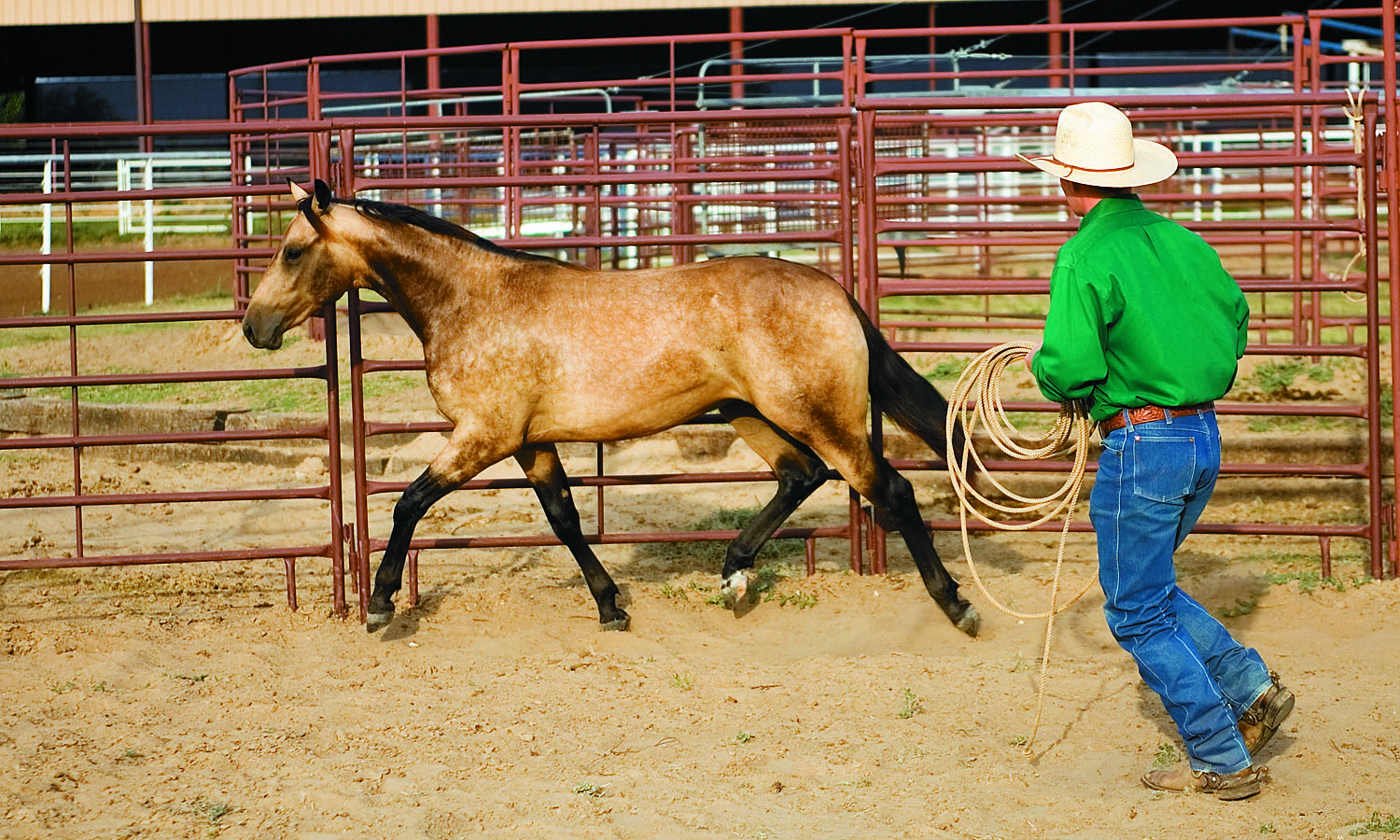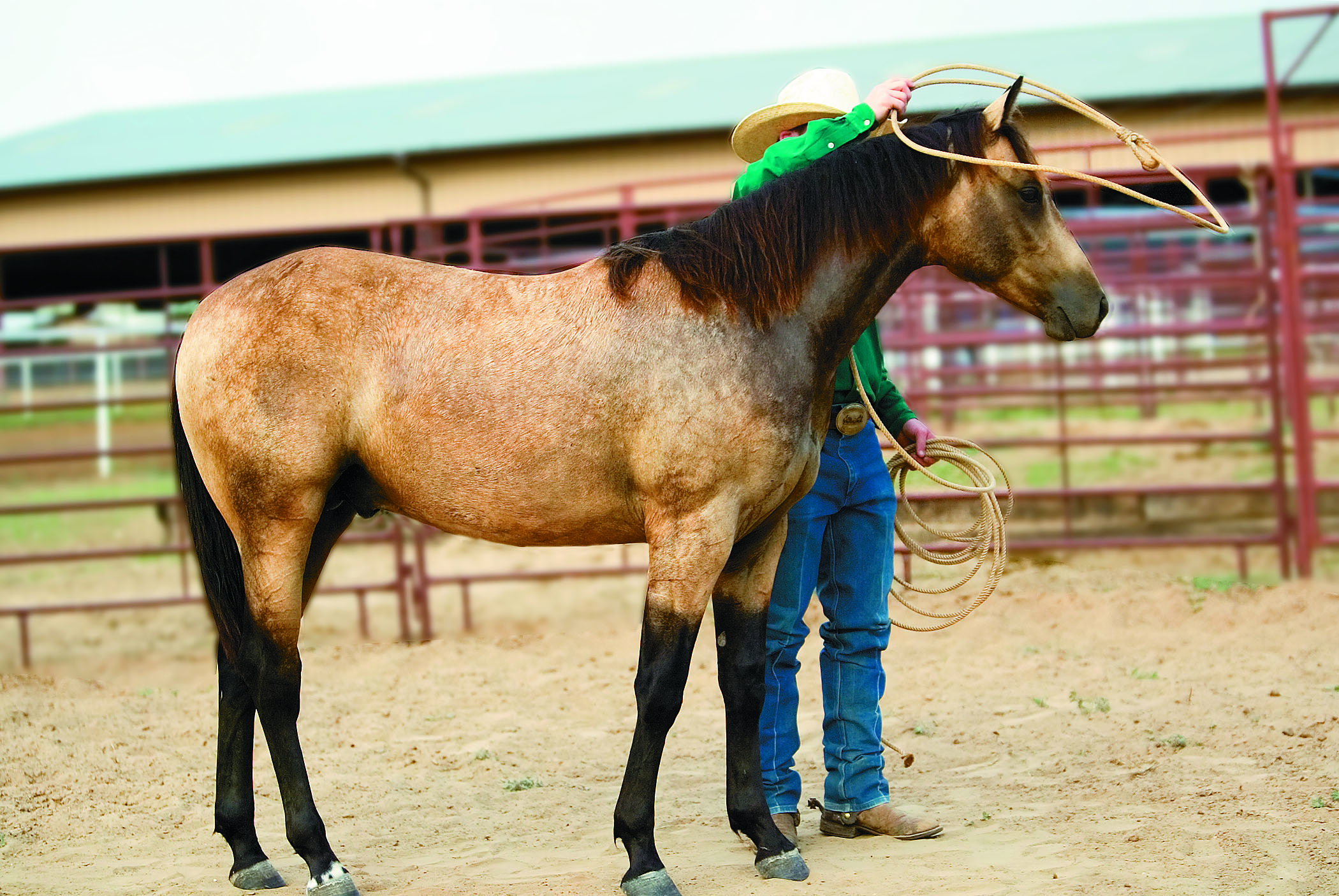
Not sure how to get your young horse started and teach him to be attentive and responsive to your cues? Try working him in a round pen. It’s important to teach your young horse to accept you as his leader—you are the boss, he’s not. I start all my yearlings in the round pen and have found this method very successful in getting them accustomed to humans, teaching them to move away from pressure, and then allowing them to come to relief. In simple terms, we’re going to make your youngster a “yes” horse who enjoys his job, not a “no” horse who doesn’t respect your leadership.
Read More: Building Trust With Your Horse
Round pen training will also prevent your horse from avoiding you, and will force him to focus—which will ultimately increase his attention span. And his learning to respect your space will eliminate dangerous problems such as him crowding you through gates and stall doors, or having him bump or walk into you while you lead him.
With all of my other responsibilities at my breeding and training facility, I don’t personally work my yearlings in the round pen any more. But I have several excellent assistants that I’ve trained to do round pen work. For this lesson my assistant, Joe Bob Roberts, will be demonstrating the training techniques.
By the end of this lesson and after practicing the exercises I’ll explain later in this article, we want your horse to have learned the following:
• He should respond by moving away from pressure you put on him.
• He should be submissive and responsive to your body language.
• He should be willing to engage with humans—not want to escape.
• He should demonstrate patience by standing still.
• He should be willing and easy to catch in the pasture—ideally he’ll learn to come up to you on his own.
• He’ll be better mentally prepared for more difficult lessons—round pen work initiates his thought-processing skills.
• He should stand, follow, and lead at your command.
What you’ll need for this lesson:
• Secure round pen (45 to 60 feet)
• Nylon rope (30 to 50 feet)
• Protective boots for your horse
• Halter
Let’s get started:
Before you bring your youngster into the round pen, make sure your pen is safe and secure. Check the footing for holes, rocks, or uneven ground, and make sure the boards to your pen are secure and are without protruding nails or other sharp objects. I prefer to use a round pen 45 feet in diameter—that way I don’t have to jog to keep up with my horse. You can comfortably walk a 10-foot circle to move with your horse in a 45-foot pen. Some people prefer to use a larger pen to avoid feeling crowded. Either way works, but always remember if you’re working in a smaller pen, stay out of your horse’s kicking range. The pen’s fencing should be 6 to 7 feet high, so that your horse can’t get his head over the fence, or worse, jump out of the pen with the onset of your pressure.
Read More: Establish Control on the Longe Line

Use protective boots to protect your horse’s legs from injury while he’s working in the pen and trying to figure out where is legs are going—especially if he’s a fresh little guy that doesn’t have experience working in a round pen. The colt we’ve pictured for this article has had lots of practice in the round pen, and is therefore careful with his legs, so we didn’t put boots on him.
And, of course, always put safety first. Be aware that you horse may kick out at you, or try to run into you. Pay attention to his body language. If he looks agitated, like he’s going to kick, get out of the way and then use your rope to keep him moving. If you keep him moving away from the rope, he’s not going to be able to kick or run into you.
1. Put a halter with a lead rope on your horse and his protective boots (regular splint boots work well). At this point you’ll need your rope. I recommend using a nylon rope—approximately 30 to 50 feet long—rather than a longe whip because you’ll have a better range of motion with a rope. Go ahead and lead your horse into the round pen, and once inside, remove the lead rope—you can keep the halter on, or take it off. I personally take the halter off, because when your horse is learning to walk to you in the pen, you may be tempted to grab the halter and pull him to you. That’s not what we want—he should walk to you. Make sure the entrance gate is closed and secure. If your youngster is especially rambunctious or insecure about the pen, let him hang out inside for a while to relax and get accustomed to his surroundings. Once he seems to have chilled out, it’s time for you to take a more dominant role.

2. Stand close to the center of the round pen, encourage your horse to move forward using your arms and a cluck, and if he doesn’t move, throw your coiled rope with a loop at the end (holding on to the other end, of course) towards your horse’s inside hip and belly area. Make sure you’re using clear and concise cues by stepping in an aggressive manner as you toss the rope. You should be standing up tall with your shoulders back, and maintain eye contact with your horse. Make sure you don’t inadvertently throw the rope towards the front end of your horse’s body—that will block his space to move forward. You want to keep the “door” open for him to move away from the rope.
If your horse doesn’t move off immediately, throw your rope again towards his hip and back end, being careful not to get into his kicking range. He should move forward around the pen at a trot or lope. If he still doesn’t understand that he’s supposed to move forward, give him a little “pop” with the loop end of your rope to let him know you mean business.
At first, it doesn’t matter which direction you begin on, but as your horse advances and becomes more responsive to your cues, you’ll want to ask him to move in one direction or the other. While moving forward at a walk is acceptable, the energy created at the faster gaits will make your horse more reactive to your pressure. To convey that you would like him to continue at the trot or lope, maintain your position on a smaller inner circle, keeping the front of your body at his hip, and holding the rope slightly out.
3. After your horse has successfully gone around the pen for a while, moving off of your pressure and not trying to stop, take a step back from wherever you’re facing him, bring the rope down to your side, put your head down, and standing in an overall submissive position, back towards the round pen fence. The fence will bring him right to you. Don’t let him come to you, though, until you’ve asked him to with your passive body language. If he walks away from you or has diverted his attention to something else in or outside of the pen, throw the rope again, repeating Step 2. He’ll ultimately learn that he has to work harder if he walks away. Eventually, he’ll reach the point where he won’t leave you, and will duck his head down or lick his lips. These gestures indicate that he’s accepting you as his leader. When he does come to you and stand, reward him with verbal praises and stroke his neck or face to let him know he’s done a good job.
4. In order to change gaits—from the jog to the lope, down from the lope to the jog, and from the jog to the walk—you need to adjust your body language and the area of your horse’s body that you’re putting pressure on. If your horse doesn’t seem to want to move from the walk to the jog or from the jog to the lope, you need to put more pressure on his hind end. If he immediately zooms into a fast lope and you would like him to work at the jog or go back to the walk, move closer to his shoulder or front end. Subsequently, you’ll be “closing the door” for his forward motion. Remember that you’re the boss, so if you want him to trot, be aggressive in making him go back to the trot, and vice versa.

5. Next, ask him for a change of direction. It’s always important that you work a horse in both directions to keep both sides of his body and brain working together. The first few times it doesn’t matter whether he turns into the fence or away from it, as long as he changes direction. Aggressively step across the pen, approximately 15 to 20 feet in front of him. You should literally be stepping into his space or “bubble.” Then, if you’ve asked him to change from left to right, using your rope again, as in Step 2, ask him to move off from his right hip. If he tries to reverse directions on his own, immediately step across the pen towards him and into his space, without crowding him too much into the side of the pen. When he stops, move toward his nose, asking him to turn back the original direction. As soon as he’s facing the other way, step towards his hind end again asking him to move forward, and if he doesn’t, throw your rope.
6. Ask him to stop and come to you in the center of the pen, as we talked about in Step 3. Again, we want him to stand patiently in front of you indicating that his attention is on you. He should be focused on what you’re going to ask him to do next, but he should also be respecting your space and not crowding you or bumping you with his nose. Next, we want to get him used to being touched and comfortable with human contact. You’re going to desensitize him to the rope by running it over his body. Run it along his back, hindquarters, and sides. Be gentle and carefully watch his body language for signs of kicking (ears pinned back, swishing tail). After he’s let you do this for several minutes, praise him verbally and with a pat.
Then take the loop end of the rope and put it over his head, slowly and carefully, making sure that you don’t startle him. Remove the rope and put it over his head again, letting him get used to it around his ears as you put it on. This is an excellent technique to get him used to human contact and willingly hold still as you’ve asked him. He also learns that you’re in control of the rope—you can use it to make him move forward, or you earns you’re the boss, and he should trust you.

Read More: Harmonize Your Horsemanship
Remember: Round pen work takes practice and patience. Try not to get frustrated if your youngster doesn’t understand what you’re asking him to do at first. Keep repeating the steps I’ve outlined here in a calm but dominant manner, and he’ll eventually understand your cues. Watch your horse carefully for signs that he’s tired, nervous, or stressed. When young horses get too frazzled they won’t be able to focus on what you’re asking them to do. If your horse does appear to be overly stressed (signs may include pinned ears, a swishing tail, or repeated attempts to run too close to you), take a five-minute break. Let him relax and regain his composure, ask him to do a step he can easily accomplish, and then quit on a positive note.
There’s really no set amount of time for working in the round pen, but I recommend that you work him around three days: 30 minutes on the first day; 20 minutes on the second day; and 15 minutes on the third day, although you may have to adjust the time of your sessions according to your horse’s responsiveness. By that time, he should’ve gotten the hang of what you’re trying to teach him, but if he starts to act ornery in the pasture or won’t let you catch him, do a round pen tune-up session. You may want to do a tune-up lesson once a month in any event to keep him thinking and responding to you.
In the end you’ll not only have bonded with your youngster, but you’ll have gained his respect—an accomplishment that will perpetuate his future training. ν
Clint Haverty was recently inducted into the National Reining Horse Association Hall of Fame, and has been training reiners for almost 30 years. Haverty Ranch’s versatile Paint stallion Mark This Spot won the APHA Paint Futurity in 1997, the 1998 APHA world championship in junior reining, and was a NRHA open Futurity finalist in 1998 with Clint on board. Another Haverty owned-stallion, Who Whiz It, was also an open NRHA Futurity finalist and won the Triple Crown Challenge and the Cosequin/USET open reining championship in Florida in 2004 with Clint in the saddle. Clint owns and operates Haverty Ranch, a training and breeding facility, in Krum, Texas, with his wife, Liz, and his son, Zane.

